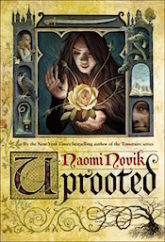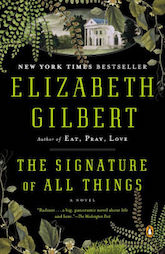The natural world has always, it seems, been the abode of the magical—and the unknown. And that which is unknown, or poorly understood, can be terrifying. It might be the deep, dark, dangerous woods that Little Red Riding Hood must traverse, or it might be more anthropomorphic, like the ferocious otherness of the Cailleach crone-goddess in Celtic myth, who transforms herself into a rock at the onset of spring. (A squishy, warm rock, we are told.)
Of course, nature can also be dangerous in other ways. Knowledge of its mysteries, in the right hands, can alarm and threaten others. The five novels below each play with the peril, and wonder, of nature in different ways.
Uprooted by Naomi Novik
 Agniezska’s village lies between two dangers: the Wood, and the Dragon. For years, the Dragon has kept the encroaching Wood at bay, but only by demanding a sacrifice from the villagers: a new young woman to serve him every ten years. This year he will choose again, and it won’t be Agniezska’s best friend he will take … but her. Agniezska must learn her own power—and ultimately venture into the heart of the Wood itself to discover the truth about what lies there.
Agniezska’s village lies between two dangers: the Wood, and the Dragon. For years, the Dragon has kept the encroaching Wood at bay, but only by demanding a sacrifice from the villagers: a new young woman to serve him every ten years. This year he will choose again, and it won’t be Agniezska’s best friend he will take … but her. Agniezska must learn her own power—and ultimately venture into the heart of the Wood itself to discover the truth about what lies there.
Wild Beauty by Anna-Marie McLemore
 This gorgeous novel features the ultimate enchanted garden, La Pradera, tended to by generations of Nomeolvides women. It is not a safe place, nor are the Nomeolvides safe women, for if they fall too far in love, their beloveds vanish. Out of this magical setting comes a boy who does not remember his name or his past, rescued by the Nomeolvides girl Estrella. Together with her family, they will piece together the secrets that lie hidden in the bones of La Pradera.
This gorgeous novel features the ultimate enchanted garden, La Pradera, tended to by generations of Nomeolvides women. It is not a safe place, nor are the Nomeolvides safe women, for if they fall too far in love, their beloveds vanish. Out of this magical setting comes a boy who does not remember his name or his past, rescued by the Nomeolvides girl Estrella. Together with her family, they will piece together the secrets that lie hidden in the bones of La Pradera.
Circe by Madeline Miller
 Circe is, of course, familiar to everyone from their high school English classes as the witch in the Odyssey who turned Odysseus’s men into pigs. Here, she tells her own magnificent story. Spanning millennia, it follows Circe’s journey from the cruel, lonely underground realm of the Titans to her beloved isle of Aiaia. Circe slowly comes into her own strength and power through an intuitive understanding of plants and herblore, from which she is able to create magic—and ultimately make a stand for herself against the gods who control her life.
Circe is, of course, familiar to everyone from their high school English classes as the witch in the Odyssey who turned Odysseus’s men into pigs. Here, she tells her own magnificent story. Spanning millennia, it follows Circe’s journey from the cruel, lonely underground realm of the Titans to her beloved isle of Aiaia. Circe slowly comes into her own strength and power through an intuitive understanding of plants and herblore, from which she is able to create magic—and ultimately make a stand for herself against the gods who control her life.
The Signature of All Things by Elizabeth Gilbert
 This globe-spanning novel is the story of Alma Whittaker, born in 1800 to a wealthy English father in Philadelphia, who grows up to become a botanist. Specifically, an expert on moss. One might say nature is dangerous here because Alma’s pursuit of science drives her away from the status quo of her time, transforming her into an utterly unique individual. And Alma’s driving curiosity spurs her not only to explore the natural world, but to discover the depths of her own nature.
This globe-spanning novel is the story of Alma Whittaker, born in 1800 to a wealthy English father in Philadelphia, who grows up to become a botanist. Specifically, an expert on moss. One might say nature is dangerous here because Alma’s pursuit of science drives her away from the status quo of her time, transforming her into an utterly unique individual. And Alma’s driving curiosity spurs her not only to explore the natural world, but to discover the depths of her own nature.
The Fifth Season by N.K. Jemisin
 Is there any better example of nature-as-dangerous than the orogenes and stone eaters of the Broken Earth series? On a supercontinent rife with seismic catastrophes and natural disasters, three women follow very different, and equally heartbreaking, journeys. The only thing more dangerous than the people who inhabit this world is the setting itself—where, we are told, the world is about to end for the last time.
Is there any better example of nature-as-dangerous than the orogenes and stone eaters of the Broken Earth series? On a supercontinent rife with seismic catastrophes and natural disasters, three women follow very different, and equally heartbreaking, journeys. The only thing more dangerous than the people who inhabit this world is the setting itself—where, we are told, the world is about to end for the last time.
 Callie Bates is the author of The Waking Land and its brand new sequel, The Memory of Fire. She is also a harpist and certified harp therapist, sometimes artist, and nature nerd. When she’s not creating, she’s hitting the trails or streets and exploring new places. Follow her on Instagram @callie_bates, Twitter @calliebywords or visit her website.
Callie Bates is the author of The Waking Land and its brand new sequel, The Memory of Fire. She is also a harpist and certified harp therapist, sometimes artist, and nature nerd. When she’s not creating, she’s hitting the trails or streets and exploring new places. Follow her on Instagram @callie_bates, Twitter @calliebywords or visit her website.










